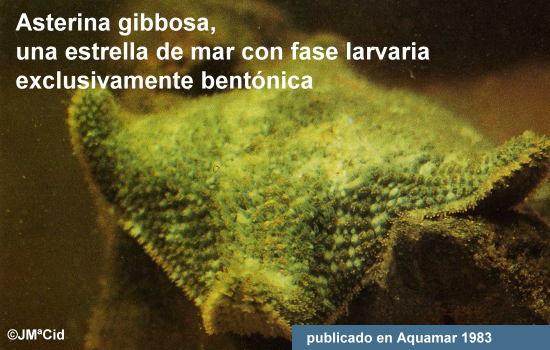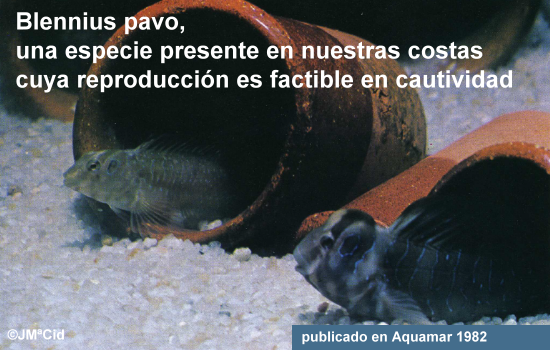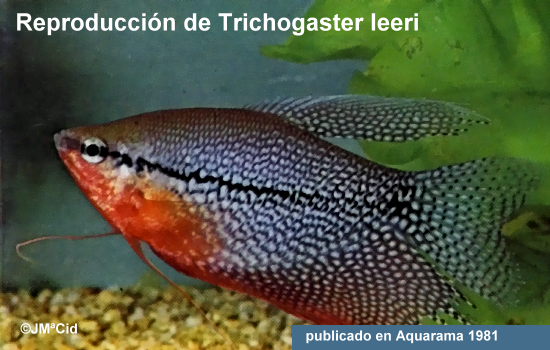Home
[th-aps layout=»bar_style»]
Asterina gibbosa, una estrella de mar con fase larvaria bentónica
<!—->
Resumen
En este trabajo, su autor, José María Cid Ruiz, nos detalla algunos aspectos relevantes de la vida en acuario de Asterina gibosa, una pequeña estrella de mar con fase larvaria exclusivamente bentónica. La ausencia tras la eclosión del huevo, de estadios de nado libre en la larva de esta especie hermafrodita, favorece el seguimiento de su evolución hasta transformarse en un ejemplar adulto y posibilita un control sobre las larvas que garantiza la supervivencia de una parte de la joven generación de estrellas de mar. Asterina gibossa es un invertebrado marino que se adapta con aparente facilidad a las condiciones de vida en el acuario. De hecho, muchos autores coinciden en señalar que se trata de una especie que tolera las fluctuaciones en la salinidad del medio, notablemente mejor que la mayoría de los equinodermos. La especie desova, depositando en las paredes del acuario varios miles de huevos de color anaranjado. Es entre el tercer y cuarto día desde la realización de la puesta, cuando se detectan los primeros movimientos en las larvas recién nacidas. Las larvas presentan un aspecto informe.
Abstract
In this work, its author, José María Cid Ruiz, details some relevant aspects about the life in the aquarium of Asterina gibosa, a small starfish with exclusively benthic larval phase. The absence after hatching of the egg, of free-swimming stages in the larva of this hermaphrodite species, favors the monitoring of its evolution until it becomes an adult specimen and enables control over the larvae that guarantees the survival of part of the young generation of starfish. Asterina gibossa is a marine invertebrate with apparent ease adaptation to live in aquarium. In fact, many authors agree that it is a species that tolerates fluctuations in the salinity of the environment, notably better than most echinoderms. The species spawns, depositing several thousand orange eggs on the walls of the aquarium. It is between the third and fourth day after laying, when the first movements are detected in the newly hatched larvae. The larvae have a shapeless appearance.
Blennius pavo, una especie presente en nuestras costas
<!—->
Resumen
“Frecuentemente al observar de frente a un blenio, se tiene la impresión de estar siendo a su vez inteligentemente observado por él”. Con esta frase, José María Cid inicia este detallado trabajo sobre Salaria (Blennius) pavo, un bello blenio mediterráneo. El autor, a lo largo del trabajo nos desgrana los protocolos de formación de parejas, mantenimiento en acuario, reproducción y desarrollo de larvas de esta peculiar especie. Los blenios tienen una anatomía adaptada a la vida bentónica y, por lo tanto, son especies muy adecuadas para el mantenimiento y la reproducción del acuario. En esta especie el desarrollo embrionario dura unos doce días. Las larvas de Salaria pavo, al nacer, tienen una longitud que se aproxima a los 4 mm, son bastante esbeltas a pesar de que aún han de reabsorber una pequeña porción del saco vitelino. Sobre su dorso y flancos puede distinguirse una abundante distribución de melanóforos. Inicialmente, las larvas permanecen inmóviles «suspendidas» de la superficie del agua y sobre áreas bien iluminadas. Reabsorben el saco vitelino en pocas horas y antes de cumplirse las primeras 8 – 12 horas de vida descienden hacia las aguas medias mostrando una mayor actividad encamina da a la búsqueda de su primer alimento externo.
Abstract
«Often when looking directly at a blenny, you have the impression that you are being intelligently observed by him«. With this phrase, José María Cid begins this detailed work on Salaria (Blennius) turkey, a beautiful Mediterranean blenny. The author throughout the work details about the protocols of formation of couples, maintenance in the aquarium, reproduction and development of larvae of this special species of blennies that inhabit the Mediterranean Sea. Blennies have an anatomy adapted to benthic life and are therefore very suitable species for aquarium maintenance and reproduction. In this species the embryonic development lasts about twelve days. The larvae of Salaria pavo, at birth, are close to 4 mm long, they are quite slender despite the fact that they still have to reabsorb a small portion of the yolk sac. On its back and flanks, an abundant distribution of melanophores can be distinguished. Initially, the larvae remain motionless «suspended» from the surface of the water and over well-lit areas. They reabsorb the yolk sac in a few hours and before the first 8-12 hours of life are completed, they descend into the middle waters, showing greater activity leading to the search for their first external food.
Notas acerca del Trichogaster leeri
<!—->
Resumen
Una de las más atrayentes especies de anabántidos es sin duda alguna el “Gourami Perla” (actualmente Trichopodus leerii), huésped habitual del acuario comunitario, al que suele aclimatarse con facilidad. En este artículo, José María Cid Ruiz, nos describe los aspectos más reseñables del mantenimiento y reproducción de esta especie. Así como, los detalles de alimentación de las larvas y tiempos de desarrollo hasta la fase alevín. El autor nos refiere multitud de detalles, tales como que: “en aguas ácidas y muy cálidas (ph = 6,6; T = 28 – 30ºC), los machos de T. Leeri construyeron siempre sus nidos en presencia directa de la hembra y, en esta conducta, he podido observar que se apartan en cierta medida de los modos que tengo observados en el género Betta. Dado que, en este último, el macho se ve siempre estimulado a la construcción de nido con la simple visualización a través de un cristal de una hembra, sin tener acceso a un contacto directo. Sin embargo, los machos de T. leeri, han reiniciado la reconstrucción del nido en las diversas ocasiones, si y sólo si, la hembra, era sumergida de nuevo en su departamento, a pesar de haber disfrutado de una perfecta visión de la misma en los días precedentes.
Abstract
One of the most attractive species anabantids is undoubtedly the «Pearl Gourami» (currently Trichopodus leerii), regular guest of the community aquarium, which tends to acclimate easily. In this article, José María Cid Ruiz, describes the most notable aspects of the maintenance and reproduction of this species. As well as, the feeding details of the larvae and development times up to the juvenile phase. The author tells us a multitude of details, such as: “in acidic and very warm waters (ph = 6.6; T = 28 – 30ºC), the males of T. Leeri always built their nests in the direct presence of the female and in this behavior, I have been able to observe that they deviate to a certain extent from the ways that I have observed in the genus Betta. Since, in the latter, the male is always stimulated to build a nest with the simple visualization through a glass of a female, without having access to direct contact. However, the males of T. leeri have restarted the reconstruction of the nest on various occasions, if and only if the female was submerged again in his department, despite having enjoyed a perfect view of the female in the preceding days.




